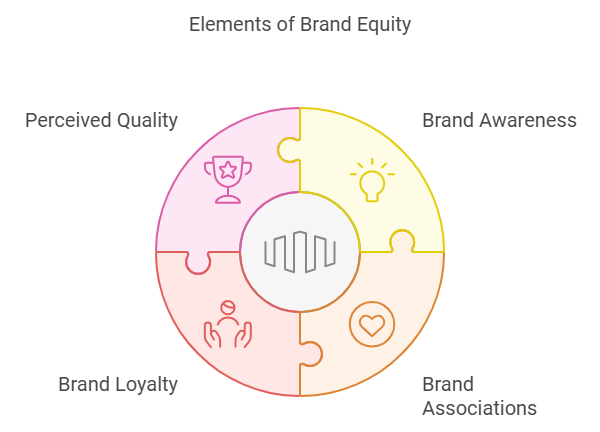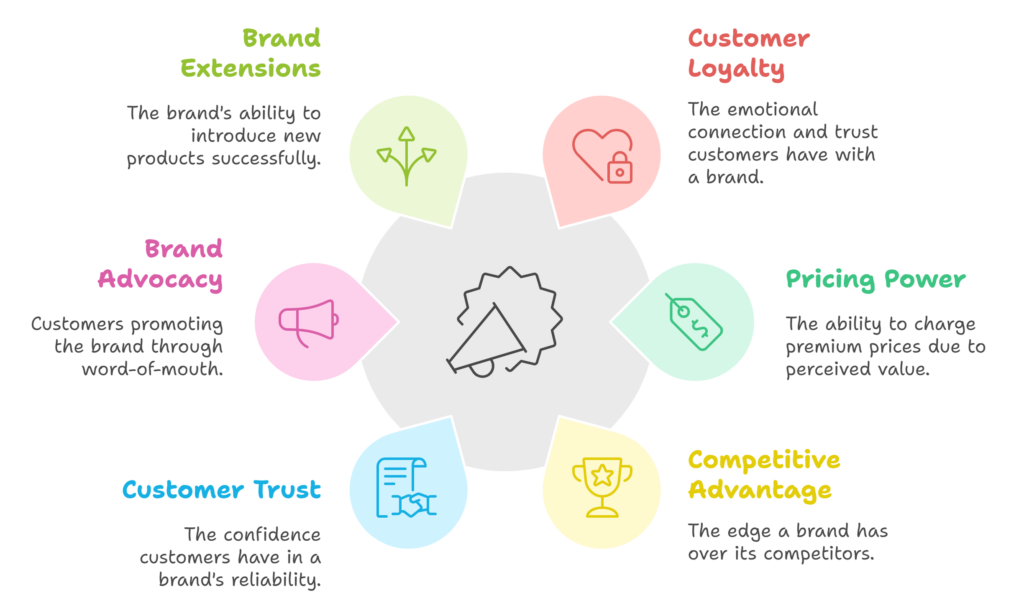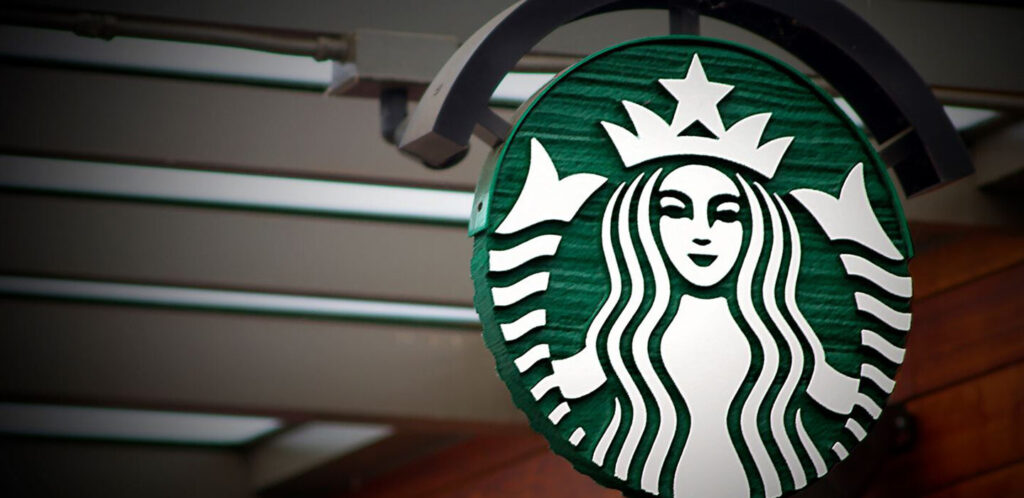Two products, almost identical in quality, price, and functionality, sit side by side on a store shelf. Yet, one outsells the other by a massive margin. The reason isn’t just about the product itself but rather the perception, the emotional connection, and the reputation that one brand has cultivated over time. This magic ingredient is called “brand equity.”
Table of Contents
But what is Brand equity? It is the difference between a product’s objective attributes and the value consumers attach to it. Companies like Apple, Coca-Cola, and Nike don’t just sell products; they sell meaning, emotions, and values that resonate with consumers. Let’s break down how brand equity works, why it’s invaluable, and how companies can measure and build this critical asset.
What is Brand Equity?
Brand equity is the value that a brand adds to a product or service beyond its functional benefits. It derives from consumers’ perceptions, experiences, and feelings about the brand. When a brand has strong equity, it can influence customer behavior, driving loyalty, repeat purchases, and even a willingness to pay a premium.
Take Nike as an example. Nike’s brand equity is built on quality, innovation, and its powerful slogan, “Just Do It.” Through its sponsorships, endorsements, and emotional advertising campaigns, Nike has become a brand that consumers trust, admire, and aspire to associate with. Consumers don’t just buy Nike products for functionality; they buy into a lifestyle that aligns with athleticism, courage, and self-improvement.
Elements of Brand Equity

Brand equity consists of several key elements:
- Brand Awareness: The extent to which consumers recognize and recall a brand.
- Brand Associations: The values, emotions, and imagery consumers associate with a brand.
- Brand Loyalty: The degree of commitment customers have to a brand, often demonstrated through repeat purchases.
- Perceived Quality: The perception of a brand’s quality in relation to competitors.
Also read: What is Product Mix? Strategies and Examples for Growth
Advantages of Brand Equity
Brand equity is one of the most powerful assets a company can possess. It refers to the tangible and intangible value that a brand adds to a product or service based on consumer perceptions, loyalty, awareness, and associations. Strong brand equity offers numerous advantages that not only contribute to business growth but also help to secure long-term success.
In this section, we’ll examine the key benefits of brand equity and explain how each can positively impact a company’s bottom line and overall reputation.

1. Customer Loyalty and Retention
One of the most significant advantages of strong brand equity is customer loyalty. When consumers develop a sense of trust and attachment to a brand, they are more likely to make repeat purchases and remain loyal over time. This loyalty results from consistent positive experiences with the brand, whether through quality products, excellent customer service, or an emotional connection that resonates with customers.
For example, brands like Apple and Nike enjoy high levels of customer loyalty. Customers return not just for the product itself but because they identify with the brand’s values and identity. Loyal customers not only continue to buy from the brand but also become brand advocates, spreading positive word-of-mouth to their networks, which further strengthens brand equity.
2. Increased Pricing Power
Companies with high brand equity often can command premium prices for their products or services. Customers perceive them as more valuable due to their strong reputation, quality, or emotional connection with the brand. This pricing power allows companies to generate higher profit margins without losing customers to cheaper alternatives.
3. Competitive Advantage
A brand with strong equity enjoys a significant competitive advantage. When a brand is well-established and trusted, it becomes more difficult for new entrants or competitors to challenge its market position. High brand equity allows companies to stand out in crowded and competitive markets, making it easier to attract new customers and maintain their position as industry leaders.
For example, Coca-Cola has a massive market share in the beverage industry, making it almost impossible for new companies to match its reach and influence. The brand’s long-standing reputation, global recognition, and customer loyalty have created a competitive moat that protects its position from competitors, even in times of price wars or market disruptions.
4. Enhanced Customer Trust
Trust is a cornerstone of any successful relationship, and this holds especially true for businesses and their customers. A brand that has built strong equity is viewed as more trustworthy. Customers are more confident in purchasing from brands they trust, as they believe the products or services will meet or exceed their expectations. In turn, this trust translates into positive brand associations and increased loyalty.
For example, brands like Amazon and Patagonia have earned significant trust over time. Amazon is known for delivering products quickly and reliably, while Patagonia’s commitment to sustainability and ethical business practices has won the trust of eco-conscious consumers.

5. Brand Advocacy and Word-of-Mouth Marketing
Strong brand equity often leads to the creation of a loyal fan base that actively promotes the brand to others. This advocacy is a valuable marketing tool, as word-of-mouth recommendations from satisfied customers are one of the most powerful forms of advertising. Customers trust the opinions of their friends, family, and peers more than traditional advertising, which makes brand advocacy essential for sustained growth.
For example, Tesla has built a massive following of advocates who not only buy its products but also promote the brand’s values of innovation, sustainability, and quality. Tesla owners often share their experiences on social media or within their communities, influencing others to consider purchasing a Tesla vehicle.
6. Easier Brand Extensions and New Product Launches
Companies with strong brand equity have a much easier time introducing new products or expanding into new markets. Consumers are more likely to trust and purchase new offerings from a brand they already know and love. This ability to leverage brand equity for brand extensions can significantly reduce the risk and cost associated with introducing new products or services.
A prime example is Nike, which successfully expanded from selling shoes to offering sportswear, accessories, and even equipment. Nike’s brand equity in the athletic and sports market allowed it to branch out with minimal resistance from consumers, as they already trusted the brand’s quality and performance.
Example of Positive Brand Equity
Some companies have built exceptionally strong brand equity over time.
Here’s an example
Starbucks

Starbucks exemplifies positive brand equity through unwavering brand consistency, a cornerstone of its global appeal and customer loyalty. Founded as a single coffee bean store in Seattle in 1971, Starbucks has evolved into the world’s largest coffeehouse chain. Its success lies in its ability to deliver a reliably familiar experience, no matter where customers are in the world. The green twin-tailed siren logo has become synonymous with quality and familiarity, signaling a promise to customers that their favorite drink will taste the same, whether ordered in Surat, San Francisco, or Shanghai.
This sense of consistency goes beyond just the taste of the coffee. From the iconic white cup to the personal touch of having a name (or a fun approximation) written on it, Starbucks has perfected its brand experience, offering customers the comfort of predictability in an increasingly dynamic world.
Beyond consistency, Starbucks also stays attuned to the evolving needs of its customers by simplifying the coffee-buying experience. Its innovative mobile app allows users to place and pay for orders ahead of time, so drinks are ready when they arrive. This app-based loyalty program offers free beverages and personalized rewards, blending convenience with a rewarding experience that deepens customer loyalty.
Today, Starbucks ranks 15th in Brand Finance’s Global 500 list of most valuable and strongest brands, a testament to its exceptional brand equity. By combining consistency with innovation, Starbucks has built a brand that’s both reliable and forward-thinking, cementing its place as a coffeehouse staple worldwide.
What is Negative Brand Equity?
Negative brand equity occurs when a brand’s name or reputation actually decreases the perceived value of a product or service. This means that consumers view the brand negatively, to the point where they may be less likely to purchase its products—or even prefer products from lesser-known brands or competitors. Instead of being an asset, the brand name becomes a liability.
Here’s why and how negative brand equity can happen:
- Poor Product Quality or Service: If a brand consistently fails to deliver quality, consumers start to associate it with disappointment. An example is Blackberry, once a leader in mobile technology, which suffered due to failing to innovate and deliver the smartphone features consumers wanted.
- Negative Publicity: Brands embroiled in scandals, legal issues, or unethical behavior can lose consumer trust. For instance, Volkswagen faced a significant drop in brand equity after the emissions scandal, which damaged its image of environmental responsibility and honesty.
- Inconsistent or Untrustworthy Marketing: Brands that make promises they don’t keep, such as exaggerated claims or deceptive marketing, can lose credibility. Pepsi faced a backlash with its controversial ad featuring Kendall Jenner, which some people saw as trivializing social issues.
- High-Profile Failures or Recalls: When products are recalled for safety reasons or are known to have serious flaws, brand equity can suffer. Boeing’s 737 MAX issue, which led to fatal crashes, damaged the company’s reputation and confidence in its products.
- Outdated Image: Sometimes, brands fail to keep up with cultural shifts and changing consumer expectations, making them appear out of touch. For example, MySpace was once a giant in social media but failed to evolve, leading users to move to Facebook and other platforms.
Difference Between Brand Equity and Brand Value
While brand equity and brand value are often used interchangeably, they’re not the same. Brand equity is about consumer perception, while brand value is the financial worth attributed to that brand. Brand value is an objective measure, usually calculated based on factors like revenue potential, market share, and profitability.
Here’s a comparison:
| Aspect | Brand Equity | Brand Value |
| Definition | Consumer perception, emotional connections, and loyalty associated with a brand | Financial worth of a brand based on revenue, market position, etc. |
| Measurement Basis | Subjective – influenced by consumer experiences, associations, and loyalty | Objective – derived from metrics like sales, profit margins, etc. |
| Impact | Influences customer loyalty, brand resilience, and pricing power | Directly impacts financial valuations and market capitalization |
| Key Drivers | Customer perceptions, brand image, brand associations | Sales revenue, profitability, brand growth |
| Examples | Apple’s customer loyalty, Coca-Cola’s nostalgic associations | The financial worth of a brand is based on revenue, market position, etc. |
Methods to Measure Brand Equity
Measuring brand equity can be challenging because it is not easily quantifiable. However, several methods exist that allow businesses to evaluate and understand the strength of their brand. Some of the most common methods to measure brand equity include:
- Customer Surveys: Surveys can help assess customer perceptions, loyalty, and awareness. Key questions could focus on brand recall, satisfaction, and preference.
- Brand Asset Valuator (BAV): The BAV model evaluates brand equity based on four pillars: differentiation, relevance, esteem, and knowledge. These dimensions help to quantify how consumers perceive a brand.
- Brand Loyalty Metrics: Measuring customer loyalty is a crucial indicator of brand equity. Companies track repeat purchases, customer lifetime value (CLV), and churn rates.
- Market Share and Financial Performance: A brand’s market share and its ability to generate revenue can provide insight into its brand equity.
- Social Media Mentions and Sentiment: Analyzing social media sentiment and the frequency of brand mentions can provide insights into consumer perceptions and brand affinity.
- Net Promoter Score (NPS): NPS is a popular tool for measuring customer loyalty and satisfaction. It tells about how likely customers are to recommend a brand to others.
Brand Equity Models
To understand and build brand equity, two primary models are widely used: Keller’s Brand Equity Model and Aaker’s Brand Equity Model. Each offers a unique framework to evaluate and grow brand equity by focusing on different components.
Keller’s Brand Equity Model and Its Components
Developed by Kevin Lane Keller, this model—also known as the Customer-Based Brand Equity (CBBE) model—explores brand equity from the perspective of consumer perception. Keller’s model is structured as a pyramid with four levels:
- Brand Identity
The first level of Keller’s model is about brand awareness. It answers the question, “Who are you?” This stage focuses on creating brand salience, ensuring that consumers recognize and recall the brand. - Brand Meaning
At this stage, consumers associate the brand with specific attributes and imagery. It’s about establishing a brand personality and positioning the brand to align with consumer expectations. - Brand Response
The third level examines how consumers react to the brand. This response is based on judgments (quality, credibility) and feelings (emotional reactions). - Brand Resonance
The pinnacle of Keller’s model is brand resonance, which reflects a deep, enduring relationship between the brand and the consumer. Resonance includes behavioral loyalty, emotional attachment, and active engagement.
Aaker’s Customer-Based Brand Equity Model and Its Components
David Aaker’s brand equity model emphasizes five key components that drive brand equity. This model is valuable for understanding the broader impact of brand equity on consumer behavior:
- Brand Loyalty
Loyalty is the cornerstone of Aaker’s model. When a brand has loyal customers, it gains a steady revenue stream and a solid foundation for growth. - Brand Awareness
Like Keller, Aaker considers awareness vital. A strong presence in consumers’ minds makes it easier to stand out in the marketplace. - Perceived Quality
High perceived quality encourages consumers to choose the brand over alternatives, reinforcing brand equity and allowing for premium pricing. - Brand Associations
The associations that come to mind when consumers think of the brand, including emotional connections, values, and experiences, all contribute to equity. - Other Proprietary Assets
Aaker also includes brand assets such as patents, trademarks, and channel relationships, which help protect the brand’s competitive advantage.
Comparing Keller’s and Aaker’s Brand Equity Models
Both models offer valuable perspectives on building and measuring brand equity, yet they differ in their approach:
- Consumer-Centric vs. Business-Centric: Keller’s model is heavily focused on the consumer’s perspective, making it ideal for brands that want to understand how they resonate with their audience. Aaker’s model, on the other hand, considers broader aspects, including proprietary assets and competitive advantages.
- Emotional Connection vs. Brand Protection: Keller’s pyramid ends with brand resonance, emphasizing emotional loyalty. Aaker, however, includes brand assets as a component, highlighting the importance of protecting the brand’s position.
To Conclude..
Brand equity is much more than a measure of brand recognition; it’s the difference between a commodity and a beloved icon. Strong brand equity helps companies weather market shifts, demand premium pricing, and achieve lasting consumer loyalty. Through models like Keller’s and Aaker’s, brands can carefully craft and nurture this intangible asset to create memorable consumer experiences.
As businesses build brand equity, they gain more than loyal customers. They secure a place in consumers’ lives, and when done right, they transform ordinary products into unforgettable brands, carrying their essence far beyond the shelves and into the hearts of their customers.

